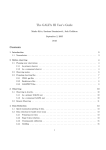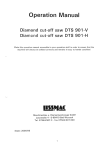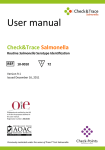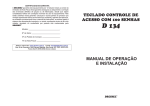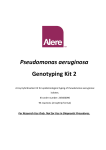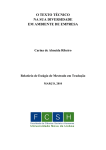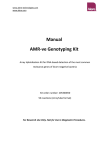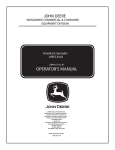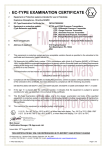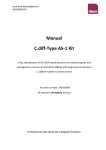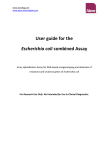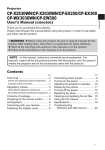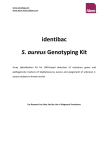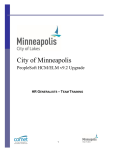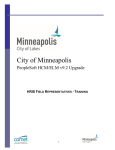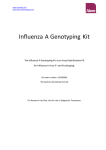Download Manual Salm-SeroGenoTyping AS
Transcript
www.alere-technologies.com www.alere.com Manual Salm-SeroGenoTyping AS-1 Kit Array Hybridisation Assay for DNA-based serogenotyping and detection of resistance genes of Salmonella and assignment of unknown Salmonella isolates to known strains Kit order number: 245700096 96 reactions (ArrayStrip format) For Research Use Only. Not Intended for Use in Clinical Diagnostics. www.alere-technologies.com www.alere.com CONTENT BACKGROUND ................................................................................................................................. 1 GENERAL INSTRUCTIONS FOR USE .................................................................................................. 2 Intended Use .............................................................................................................................. 2 Specifications .............................................................................................................................. 2 Technical Support ....................................................................................................................... 2 Safety Precautions ...................................................................................................................... 2 Material Safety Data Sheets (MSDS) .......................................................................................... 3 Shipping Precautions .................................................................................................................. 3 REAGENTS AND DEVICES ................................................................................................................. 4 Assay Components, Storage and Stability .................................................................................. 4 Cell Lysis (optional order) ......................................................................................................... 4 DNA Labelling and Amplification .............................................................................................. 4 Hybridisation and Detection..................................................................................................... 5 Instrumentation and Software ................................................................................................. 6 Components required but not provided .................................................................................. 6 PROTOCOL ....................................................................................................................................... 8 Culturing and Harvesting Bacterial Cells .................................................................................... 8 Extraction of DNA ....................................................................................................................... 8 DNA Extraction by Spin Columns (e.g. Qiagen) ........................................................................ 9 DNA Extraction by Heat Lysis.................................................................................................. 11 Linear Amplification and Internal Biotin Labelling ................................................................... 13 Hybridisation ............................................................................................................................ 14 General Remarks - Handling of Arrays ................................................................................... 14 General Remarks - Handling of Liquids .................................................................................. 15 General Remarks - The Substrate (Precipitating Dye) D1 ...................................................... 16 General Remarks - Thermoshakers ........................................................................................ 16 Protocol for Quantifoil’s BioShake iQ and Eppendorf’s Thermomixer Comfort with microtitre plate adapter ......................................................................................................... 17 Data Analysis............................................................................................................................. 19 Starting the ArrayMate Reader .............................................................................................. 19 Worklist................................................................................................................................... 19 Data Acquisition in the ArrayMate Reader ............................................................................ 21 Results..................................................................................................................................... 23 Export of Salm-SeroGenotyping AS-1 Test Reports ............................................................... 24 TROUBLESHOOTING ...................................................................................................................... 25 Staining Control ........................................................................................................................ 26 Image Quality............................................................................................................................ 26 DNA Quality .............................................................................................................................. 26 Physical Damage to the Array .................................................................................................. 27 Report Unavailable ................................................................................................................... 27 ADDITIONAL INFORMATION ......................................................................................................... 28 Warranty ................................................................................................................................... 28 Disclaimer ................................................................................................................................. 28 Salm-SeroGenoTyping AS-1 Kit 05_16_04_0010_V01_Manual Salm-SeroGenoTyping AS-1 www.alere-technologies.com www.alere.com Quality Control ......................................................................................................................... 29 List of Components for Separate Order ................................................................................... 29 Legal Manufacturer .................................................................................................................. 29 Contact...................................................................................................................................... 30 LITERATURE ................................................................................................................................... 30 UPDATES AND SOFTWARE ............................................................................................................ 30 APPENDIX 1 – FLOW CHART .......................................................................................................... 31 APPENDIX 2 – PROBE TO TARGET TABLE ...................................................................................... 33 APPENDIX 3 – TYPING INFORMATION .......................................................................................... 41 Definitions and Explanations .................................................................................................... 41 List of Currently Recognised Strains ......................................................................................... 42 Salm-SeroGenoTyping AS-1 Kit 05_16_04_0010_V02_Manual_Salm-SeroGenoTyping AS-1 www.alere-technologies.com www.alere.com BACKGROUND The Alere SeroGenoTyping AS-1 Kit for Salmonella allows DNA-based serogenotyping according to the Kauffmann-White scheme and an assignment of unknown Salmonella isolates to known strains as well as, simultaneously, the detection of resistance genes of Salmonella. RNA-free, unfragmented genomic DNA from pure and monoclonal Salmonella culture material is amplified approximately 50-fold and internally labelled with biotin-11-dUTP using a linear amplification protocol. In contrast to standard PCR, only one antisense primer per target is used resulting in single stranded (ss) DNA reaction products. This allows a simultaneous sequence specific labelling and amplification of an essentially unlimited number of targets. However, sensitivity is lower than in a standard PCR (whereas contamination with undesired amplicons is nearly impossible) and for that reason the method is restricted to clonal culture material and cannot be performed on samples such as swabs or other patient samples (e.g. faeces). Resulting biotin labelled ssDNA is transferred and hybridised to DNA oligonucleotide microarrays with 329 covalently immobilised probes for different genetic markers and a biotin staining control. All of them are printed in two duplicate spots. The target set consists of a variety of species and serotyping markers including genes encoding 28 O-antigens and 86 H-antigens (H1 and H2). Additionally, 77 targets analysing antimicrobial resistance (AMR) genes were included (Braun et al. 2012). Spot recognition is performed automatically based on a digital image of the arrays. The overall pattern is analysed automatically for the presence or absence of specific genes and it is compared to a database of strain profiles. This allows the assignment of the serovar, the antigenic formula to Kauffmann-White and the AMR profile. Salm-SeroGenoTyping AS-1 Kit 05_16_04_0010_V02_Manual_Salm-SeroGenoTyping AS-1 1 www.alere-technologies.com www.alere.com GENERAL INSTRUCTIONS FOR USE Intended Use For Research Use Only. Not Intended for Use in Clinical Diagnostics. This kit allows genotypic characterisation of bacterial cultures from Salmonella isolates for research and epidemiological applications. It must not be used as a substitute for phenotypic susceptibility tests and for the guidance of antibiotic therapy. It cannot be used for bacteria other than Salmonella. Specifications Upon receipt, the kit components need to be stored at different temperatures as specified on the package insert. The kit is to be performed at an ambient temperature of 18-28 °C. Technical Support If you require any further information on this product please contact: email: [email protected] phone: +49 (0) 36 41 3111-155 Fax: + 49 (0) 36 41 3111-120 For up-to-date information regarding the kit, please visit our website at http://www.alere-technologies.com Safety Precautions The kit is intended for use by personnel that are trained in microbiological and molecular methods. Preparation of DNA from pure Salmonella colonies (clones) requires expertise in Salm-SeroGenoTyping AS-1 Kit 05_16_04_0010_V02_Manual_Salm-SeroGenoTyping AS-1 2 www.alere-technologies.com www.alere.com microbiology and the local regulations for handling of pathogenic microorganisms (biosafety level 2) are to be obeyed. Isolated, cell-free Salmonella DNA may be processed without further biosafety precautions, although contamination with Salmonella or other bacteria needs to be ruled out. Always wear protective clothing as required for laboratory work according to your local regulations. Material Safety Data Sheets (MSDS) According to OSHA 29CFR1910.1200, Commonwealth of Australia [NOHSC: 1005, 1008(1999)] and the latest amendments to the European Union Directives 67/548/EC and 1999/45/EC, the enclosed reagents do not require a Material Safety Data Sheet (MSDS). They do not contain more than 1% of a component classified as hazardous and do not contain more than 0.1 % of a component classified as carcinogenic. MSDS therefore are not provided. Nevertheless, the buffers may cause irritation if they come into contact with eyes or skin, and may cause harm if swallowed. The regular precautions associated with laboratory work should be obeyed (e.g. wear protective goggles, gloves and lab coat and avoid contact with the reagents). In case, any liquids are spilled, clean with disinfectant and/or laboratory detergent and water. Alere assumes no liability for damage resulting from handling or contact with these products. If you have any questions please contact our Technical Support (see above). Shipping Precautions RID/ADR: Kein Gefahrgut / No dangerous goods IMDG: No dangerous goods IATA: No dangerous goods Salm-SeroGenoTyping AS-1 Kit 05_16_04_0010_V02_Manual_Salm-SeroGenoTyping AS-1 3 www.alere-technologies.com www.alere.com REAGENTS AND DEVICES Assay Components, Storage and Stability All reagents are provided in surplus (see below). If necessary, all components may also be ordered separately; please refer to the order numbers at the end of this manual. For pricing please contact your local representative or our customer service, respectively. The expiry date can be found on each bottle and on the outer packaging. All components were tested for stability for short term shipment (<1 week) at ambient temperature (< 37 °C). The kit components with limited stability are D1 and C3. The other components proved to be stable even six months after passing the kit expiry date. Cell Lysis (optional order) • A1: Lysis Buffer (cat# 245101000) Store at 18-28 °C (ambient temperature). Surplus: 50 %. • A2: Lysis Enhancer (lyophilised, cat# 245102000) Store at 18-28 °C (ambient temperature). Centrifuge A2 tubes shortly prior to opening. Add 200 µl Buffer A1 to Lysis Enhancer before use. Mix well and store for less than 1 week at 2-8 °C. Sufficient for 96 isolations. DNA Labelling and Amplification • B1+: Labelling Buffer, Store at 2-8 °C. Surplus: 40 %. • B2: Labelling Enzyme, Store at 2-8 °C. Surplus: 100 %. • B3Salm: lyophilised Labelling Primermix, three tubes, dilute each in 70 µl molecular grade water. Store at -20 °C. Surplus: 100%. Salm-SeroGenoTyping AS-1 Kit 05_16_04_0010_V02_Manual_Salm-SeroGenoTyping AS-1 4 www.alere-technologies.com www.alere.com Hybridisation and Detection • ArrayStrips (12 x 8 samples), Protected against light and sealed under inert gas. Store at 18-28 °C. After opening to be used within two weeks. Close the unused wells with caps to protect against humidity and dust, and store in the dark. Avoid any touching or scratching of the microarray surface at the bottom of the well. Do not store or handle unused wells at more than 60 % relative humidity since this may irreversibly corrode the spots. • StripCaps (24 units) • C1: Hybridisation Buffer Store at 18-28 °C, protect against sunlight. Surplus: 150 %. • C2: Washing Buffer 1 Store at 18-28 °C, protect against direct sunlight. Surplus: 200 %. • C3: HRP Conjugate 100 x Store at 2-8 °C, protect against direct sunlight. Surplus: 100 %. • C4: Conjugate Buffer Store at 18-28 °C, protect against direct sunlight. Surplus: 200 %. • C5: Washing Buffer 2 Store at 18-28 °C, protect against direct sunlight. Surplus: 200 %. • D1: Horseradish Peroxidase Substrate Store at 2-8 °C, protect against direct sunlight. Surplus: 50 %. • optional: CMLT2: Reference DNA from S.e.e. Typhimurium LT2 (GenBank accession number NC_003197.1), cDNA = 0.1-0.4 µg/µl. Store at 2-8 °C. Sufficient for 5-6 tests. Salm-SeroGenoTyping AS-1 Kit 05_16_04_0010_V02_Manual_Salm-SeroGenoTyping AS-1 5 www.alere-technologies.com www.alere.com Instrumentation and Software • ArrayMate Reader (to be ordered separately, for details see below) The Salm-SeroGenoTyping AS-1 Kit may be used on the ArrayMate reader only. The alternative devices ATR01/03 are not suitable for reading ArrayStrip based assays. In case of any questions please contact us. • Iconoclust software (provided with the reader) • Test specific software plug-in (can be downloaded from Alere website, check periodically for updates, for details see below). Information (such as spot names, marker names, location of the spots on the array, size of the image taken by the reader’s specific camera) is delivered with the reader or can be downloaded from our website. These test specific plug-ins will occasionally be updated. Please check the NEWS section of our website http://www.clondiag.com. Support is available under [email protected]. Components required but not provided • Growth media for the cultivation of Salmonella. The test should be performed with colonies harvested from 2 x TY Agar. Other rich media (e.g. Standard 1 or LB) may also suffice, but have not systematically been tested. Liquid media should also not been used because contaminations or mixed cultures cannot easily be ruled out. • Equipment and consumables needed for the cultivation of Salmonella (incubator, inoculation loops, Petri dishes) • DNA preparation kits: The kit was tested with the DNeasy Blood & Tissue Kit from Qiagen (cat# 69504) and High Pure DNA Isolation Kit from Roche (cat# 11796828001). Please note: The DNA specimen needs to be free of RNA. Recommendation: a pretreatment with the cell lysis components A1 / A2 (see below) or a standard RNase A treatment while DNA preparation. Salm-SeroGenoTyping AS-1 Kit 05_16_04_0010_V02_Manual_Salm-SeroGenoTyping AS-1 6 www.alere-technologies.com www.alere.com • Equipment needed for DNA isolation, e.g. pipettes, centrifuge, thermoshaker or automated device (see above) • Photometer (OD260 nm) for measuring the concentration of DNA • Equipment for non denaturing agarose DNA gel electrophoresis for quality control of DNA • Thermocycler for PCR • Thermoshaker We strongly recommend the BioShake iQ by Quantifoil Instruments (http://www.qinstruments.com/) equipped with a customised heating block designed to fit ArrayStrips. Alternatively, you may use Eppendorf’s Thermomixer Comfort, equipped a heating block for microtitre plates. • Pipettes: suitable for 1-5 µl volumes, 90 µl, 100 µl, 200 µl, 1000 µl • Multichannel pipettes for 100-200 µl • Reaction vials suitable for PCR • Ultrapure (PCR grade) water • RNAse A (we recommend Qiagen’s RNase A solution, 100 mg / mL, Qiagen, cat# 19101). • Pasteur pipettes (VWR, cat# 612-2856). Salm-SeroGenoTyping AS-1 Kit 05_16_04_0010_V02_Manual_Salm-SeroGenoTyping AS-1 7 www.alere-technologies.com www.alere.com PROTOCOL Culturing and Harvesting Bacterial Cells Serovars of the genus Salmonella are potential pathogens. All procedures for cultivation of the bacterium and DNA preparation need to be performed by properly trained staff in a biosafety level 2 facility. Grow Salmonella on 2 x TY agar (overnight at 37 °C or 48 hrs at room temperature). Obtain confirmation of the identification as Salmonella (EN ISO 6579:2002/Amd 1:2007, Anonymous 2007) and make sure that you have a pure, monoclonal culture of Salmonella. Contamination with other bacteria, especially with other Enterobacteriaceae, needs to be strictly avoided as they might carry the same resistance genes as certain Salmonella strains and thus can introduce false positive signals and patterns. Extraction of DNA The required sample quantity is 0.5-2 µg (cDNA = 0.1-0.4 µg / µl) of intact genomic DNA from a single clone. The DNA specimen needs to be free of RNA and it should not be fragmented. This can be determined by agarose gel electrophoresis. DNA should not be prepared by disrupting Salmonella cells using bead beaters, ultrasonication or aggressive chemicals such as in alkaline lysis protocols. Most performance problems with the Salmonella Serogenotyping kit are due to insufficient amounts or quality of DNA preparation. We therefore strongly recommend to obey the protocols outlined below. Salm-SeroGenoTyping AS-1 Kit 05_16_04_0010_V02_Manual_Salm-SeroGenoTyping AS-1 8 www.alere-technologies.com www.alere.com DNA Extraction by spin columns (e.g. Qiagen) • Add an inoculating loop full of monoclonal colony material of the Salmonella isolate to 0.2 ml 1 x PBS and vortex thoroughly. loop empty loop full It is important to harvest enough bacteria; this is prerequisite for extraction of a sufficient amount of DNA. Take an inoculating loop 1 mm in diameter filled with bacteria as shown in the righthand picture. Optional cell lysis with A1 / A2 reagent (instead of 1 x PBS): • Centrifuge A2 tube shortly, open it, add 0.2 ml of Lysis Buffer A1 to Lysis Enhancer A2 and dissolve. • Add an inoculating loop full of monoclonal colony material of the Salmonella isolate to A1 / A2 reagent and vortex thoroughly. • Incubate the colony material of the Salmonella isolate in A1 / A2 for 30-60 min at 37 °C and 550 rpm in the thermoshaker. • Proceed with DNA preparation protocol of the DNA preparation kit. For the Qiagen DNeasy Blood & Tissue Kit it is as follows: • Add 20 µl proteinase K (Qiagen Kit, or equivalent) and add 200 µl buffer AL (Qiagen Kit). • Vortex briefly or shake vigorously. • Incubate for 30-60 min at 56 °C and 550 rpm in the thermoshaker. • Important: If A1 / A2 reagent not used, add 4 μl RNase A (100 mg / ml), mix by vortexing, and incubate for 2 min at room temperature before continuing. • Add 200 µl ethanol (96-100 %). • Vortex the sample and centrifuge (quick spin). • Transfer the complete content of the tube (including any precipitate) into a spin column Salm-SeroGenoTyping AS-1 Kit 05_16_04_0010_V02_Manual_Salm-SeroGenoTyping AS-1 9 www.alere-technologies.com www.alere.com that is placed in a 2 ml collection tube. • Centrifuge at room temperature, time and speed need to be determined depending on viscosity of the sample and type of centrifuge used. All liquid should be collected in the collection tube afterwards. • Discard collection tubes with liquid. • Place the spin column in a new 2 ml collection tube (provided with the kit). • Add 500 µl Buffer AW1. • Centrifuge (8,000 rpm, 1 min) at room temperature. • Discard collection tubes with liquid. • Place the spin column in a new 2 ml collection tube (provided with the kit). • Add 500 µl Buffer AW2. • Centrifuge (14,000 rpm, 3 min) at room temperature, the membrane of the spin column should be dry, and all liquid should be in the collection tube. • Discard collection tube with liquids. • Place the spin column in a clean 1.5 ml tube (provided with the kit). • Add 50 µl Buffer AE (or PCR grade distilled water) directly onto the membrane of the spin column. • Incubate at room temperature for 1 min to elute DNA. • Centrifuge (8,000 rpm, 1 min) at room temperature. • Optional: add another 50 µl Buffer AE (or PCR grade distilled water) directly onto the membrane, incubate at room temperature for 1 min and centrifuge again. • Discard the spin column. Please note: Ethanol from Washing Buffers strongly inhibits the enzymes used in the assay. Salm-SeroGenoTyping AS-1 Kit 05_16_04_0010_V02_Manual_Salm-SeroGenoTyping AS-1 10 www.alere-technologies.com www.alere.com Contamination with Washing Buffer might occur during elution of prepared DNA by droplets adhering to the funnel of the spin columns. Thus these funnels should be gently touched and dried with sterile filter paper or wipes prior to the elution step. Alternatively, prepared DNA can be heated to evaporate ethanol (e.g. 10 min at 70 °C). • Check for DNA integrity and absence of RNA (e.g. agarose gel). If necessary, you might perform another digestion step with additional RNase A (not provided). Measure DNA concentration (A260 method), it should not be less than 0.1 µg / µl. The concentration might be increased by heating and evaporation of water, or by using a speed vac centrifuge (not recommended when the same preparation shall be used in PCR experiments). DNA Extraction by Heat Lysis Please Note: Only a fresh overnight culture can be used. After DNA extraction by heat lysis the linear amplification must be done immediately. Storage of extracted DNA is not recommended. • Add a 1 µl inoculating loop (Please Note: do not use too much culture material, see figure below) of a monoclonal Salmonella isolate to 50 µl PCR-grade distilled water and vortex thoroughly. • Incubate at 99 °C, 15 min at 550 rpm in a thermoshaker. • Centrifuge for 5 min at 13,600 rpm at room temperature. • Carefully pipette 25 µl supernatant into a new 1.5 ml tube and discard the old tube with the pellet. • Add 0.25 µl RNase A (not provided / see above) with a stock concentration of 1 mg / ml. • Incubate at 37 °C, 5 min at 550 rpm in a thermoshaker. Salm-SeroGenoTyping AS-1 Kit 05_16_04_0010_V02_Manual_Salm-SeroGenoTyping AS-1 11 www.alere-technologies.com www.alere.com • Use 5 µl of this DNA suspension for the linear amplification and internal biotin labelling process. Salm-SeroGenoTyping AS-1 Kit 05_16_04_0010_V02_Manual_Salm-SeroGenoTyping AS-1 12 www.alere-technologies.com www.alere.com Linear Amplification and Internal Biotin Labelling Please keep in mind the limited surplus of reagents whilst pipetting. The surplus of B1+ labelling reagent is 40 %. • Prepare a Master Mix by combining 3.9 µL of B1+ labelling reagent, 1 µl B3Salm Labelling Primermix and 0.1 µl of B2 (DNA polymerase) per sample. • Add 5 µl of Salmonella DNA (cDNA = 0.1-0.4 µg/µl) prepared as described above to 5 µl of the Master Mix (B1+/B2/B3Salm). Do not forget to label the vial! • Perform amplification in a pre-programmed thermocycler (e.g. Eppendorf Mastercycler gradient with heated lid, VWR, cat# 460-0108) according to the following protocol: Pre-heat cover / lid to 105 °C 300 sec at 96 °C 20 sec at 50 °C 50 cycles with 40 sec at 72 °C 60 sec at 96 °C Cool down to 4 °C, hold • The samples can be stored frozen until usage. Please note: When using another device, some adaptations might be necessary. Before starting routine use, please test the protocol with a few known reference strains. Salm-SeroGenoTyping AS-1 Kit 05_16_04_0010_V02_Manual_Salm-SeroGenoTyping AS-1 13 www.alere-technologies.com www.alere.com Hybridisation General Remarks - Handling of Arrays Never touch the array surface! Avoid complete drying of the array surface during processing! Do not allow it to stay without liquid for more than two minutes! Never rinse the wells with distilled water after the hybridisation step, use only C2 Washing Buffer! Unused wells should be capped during the whole procedure. The strips may be processed up to three times without a loss of quality of properly capped unused arrays. Close all wells that will not be used with a cap and leave it there until you use these wells (for storage conditions after use: see section “Kit Components, Storage and Stability / Hybridisation and Detection”). Always label your ArrayStrips with a laboratory marker at the recommended position. Never label them on the bottom or across the data matrix barcode! This may cause errors. Avoid contact of data matrix code with organic solvents! The ArrayMate needs the information encoded in the data matrix to perform the assay and the analysis afterwards. Avoid touching the bottom of the microarray strip and keep it clean. Salm-SeroGenoTyping AS-1 Kit 05_16_04_0010_V02_Manual_Salm-SeroGenoTyping AS-1 14 www.alere-technologies.com www.alere.com General Remarks - Handling of Liquids We recommend the use of a multichannel pipette and reagent reservoirs. We strongly recommend that the liquid is removed by pipetting rather than by inverting the strips and flicking the liquids out. Fine tipped soft, disposable Pasteur pipettes are best suited (such as VWR, cat# 612-2856). Always place the pipette tip at the cavity between the array and the wall of the reagent well. If you touch the array surface, probes may be scratched off and this may cause an error. Pipette Use the cavity between array and the wall of the tube. Do never touch the array. Array Salm-SeroGenoTyping AS-1 Kit 05_16_04_0010_V02_Manual_Salm-SeroGenoTyping AS-1 15 www.alere-technologies.com www.alere.com General Remarks - The Substrate (Precipitating Dye) D1 It is recommended to fill an appropriate amount of substrate (precipitating dye D1) into a reaction tube and taken out of the refrigerator when starting the procedure allowing it to acclimatise it to room temperature / 25 °C. Cold D1 may yield weak signals. D1 should be centrifuged (quick spin) prior to use to remove bubbles as well as possible precipitates. Triggered by peroxidase, the dye precipitates in the case of positive reactions, but it is not covalently bound. The precipitate can be dissolved by vigorous shaking. Thus, the arrays must not be shaken, dropped or moved abruptly during the staining procedure or thereafter. After completion of staining, remove and discard reagent D1 as completely as possible and scan immediately (ArrayMate). The dye precipitate fades slowly in presence of liquids. General Remarks - Thermoshakers The correct temperature within the vessels is essential; therefore always use appropriate equipment for heating. Because of the possibility of inhomogeneous distribution of temperature within the heating block, as well as possible differences between displayed and actual temperatures, the use of different brands of thermoshakers might affect test performance. We tested the kit with BioShake iQ by Quantifoil Instruments, see figure below (http://www.qinstruments.com/) equipped with a customised heating block designed to fit ArrayStrips (recommended) and Eppendorf’s Thermomixer Comfort, equipped with a heating block for microtitre plates. When using other devices, some modifications to the protocol might be necessary. Before starting routine use, please test the protocol with a few known reference strains or the control DNA CMLT2 (S.e.e. serovar Typhimurium LT2). Salm-SeroGenoTyping AS-1 Kit 05_16_04_0010_V02_Manual_Salm-SeroGenoTyping AS-1 16 www.alere-technologies.com www.alere.com BioShake iQ by Quantifoil Instruments equipped with a customised heating block designed to fit ArrayStrips (http://www.qinstruments.com/). Protocol for Quantifoil’s BioShake iQ and Eppendorf’s Thermomixer Comfort with microtitre plate adapter • Switch on the thermoshaker and pre-heat it to 55 °C. • Remove the amount of ArrayStrip(s) needed from the pouch. • Insert the ArrayStrip(s) into the white frame. Ensure the correct orientation (data matrix code close to row (A) and proper fit. • Pre-wash the array in two steps: • First, PCR-grade distilled water, 200 µl per well at 55 °C, 5 min and 550 rpm. Remove the water from the well. • Second, C1 Hybridisation Buffer, 150 µl per well at 55 °C, 5 min and 550 rpm • Add 90 µl of buffer C1 to each tube with 10 µl labelled amplification product, mix gently. • Remove the buffer from the well with the array and add the mixture of C1 and labelled amplification product. • Incubate at 55 °C, 60 min and 550 rpm. Salm-SeroGenoTyping AS-1 Kit 05_16_04_0010_V02_Manual_Salm-SeroGenoTyping AS-1 17 www.alere-technologies.com www.alere.com • Meanwhile, log on to the ArrayMate device and prepare your worklist (see section “Data Analysis” p. 17) • Remove liquid and add 200 µl C2 Washing Buffer. Incubate at 45 °C, 5 min and 550 rpm, remove and discard. • Add another 200 µl C2 Washing Buffer. Incubate at 45 °C, 5 min and 550 rpm, remove and discard. • Meanwhile, prepare the conjugate: For each experiment, add 1 µl C3 HRP conjugate to 99 µl of C4 Conjugation Buffer. This mixture is stable for around one working day at room temperature; C3 is delivered with a surplus of 100 %, C4 with a surplus of 200 %. Suggested pipetting scheme: C3 C4 • 1 well 1.5 µl 150 µl 2-3 wells 3.5 µl 350 µl 4-6 wells 7 µl 700 µl 7-10 wells 11 µl 1100 µl 11-15 wells 16 µl 1600 µl 16-20 wells 21 µl 2100 µl 21-30 wells 32 µl 3200 µl 31-40 wells 42 µl 4200 µl Remove and discard the Washing Buffer, and add 100 µl diluted conjugate C3 / C4 to each well, incubate at 30 °C, 10 min and 550 rpm. • Remove liquid and wash with 200 µl C5 Washing Buffer, just pipette up and down once, remove and discard. • Add another 200 µl C5 Washing Buffer. Incubate at 30 °C, 2 min and 550rpm. • Remove and discard Washing Buffer, add 100 µl of D1 substrate (precipitating dye, at 25 °C, see above) per well. • Incubate at 25 °C, 10 min but do not shake! • Remove liquid completely. • The outside of the bottom of the ArrayStrips may be carefully cleaned with wipes. • Scan and process (ArrayMate, see below). Salm-SeroGenoTyping AS-1 Kit 05_16_04_0010_V02_Manual_Salm-SeroGenoTyping AS-1 18 www.alere-technologies.com www.alere.com Data Analysis Starting the ArrayMate Reader We recommend to start the ArrayMate Reader after starting the hybridisation; this allows the convenience of starting the device and importing the worklist file. Please note: This is a short instruction only. For more detailed information please refer to the ArrayMate User Manual. • Switch on the ArrayMate (1st: main switch on the rear below the electric cable plug, 2nd: operating switch on the bottom left corner of the front side). • Switch on the screen (switch righthand side below the screen). • Log on as R&D User (Research and Development User) for full access to test specific software (a default password will be provided together with the ArrayMate device). If you log on as User, you will obtain raw values only, but neither interpretation of positives / negatives nor strain assignment. The Administrator log on will allow the installation of a new assay specific plug-in, which can be downloaded at http://alere-technologies.com (see p. 28). • The user interface will be loaded, the ArrayMate performs internal testing. It requires slightly less than a minute. • Click on the icon New Run (left upper edge of the screen). A suggestion for a run name / folder name for the new run appears in the top line of the screen. You may modify or change the experiment name at your convenience. • Type in your operator ID (optional). • You may enter a comment into the memo field (optional). Worklist A Worklist file allows to link an identifier such as a laboratory or sample number to a position of an array within the ArrayStrip. Please respect the rules of confidentiality and data protection. Salm-SeroGenoTyping AS-1 Kit 05_16_04_0010_V02_Manual_Salm-SeroGenoTyping AS-1 19 www.alere-technologies.com www.alere.com Worklists can be generated using spreadsheet software such as EXCEL (see below) but must be saved in the *.txt file format that can be imported into the test specific ArrayMate software. Do not use special characters (such as: ; ()[] / \ ä ü etc.). • Create a list with at least three columns with obligatory headers in the following order: position / sample ID / assay ID (table 1). • Positions are consecutively numbered from 1 to a maximum of 96. Position 1 would correspond to A1, 8 to H1, 9 to A2 and 96 to H12 (table 2). Do not leave empty lines in the worklist. If you use EXCEL, position numbers should be entered into column A. • Sample ID is strain / sample / laboratory number such as exported from your LIMS (or assigned in any different way). Patient name should not be used as sample ID. • The Assay ID enables the system to identify the current test and to correctly use information on layout, spot number, and identity etc. The Salm-SeroGenotyping AS-1 Kit has the Assay ID: 10624. Please note: Assay ID numbers must not be confused as this could lead to errors or loss of data. • You may add further columns and headers with notes and comments at your convenience. Information from these columns will not appear on the result screen or in the Test Report. • We recommend using a printout of the worklist as a template for pipetting. • Save the worklist as tab separated *.txt file on the memory stick provided together with the ArrayMate. • To avoid confusion, make sure that worklists are named unambiguously or that worklists from earlier experiments are deleted. Table 1: Example worklist. Please note: Table header must be written exactly as shown. Position 1 2 3 4 5 Sample ID 2013-12345 2013-12346 2013-12347 2013-12348 2013-12349 Assay ID 10624 10624 10624 10624 10624 Salm-SeroGenoTyping AS-1 Kit 05_16_04_0010_V02_Manual_Salm-SeroGenoTyping AS-1 Comment 20 www.alere-technologies.com www.alere.com 6 2013-12350 7 987654 8 CMLT2 Table 2: Positions in the 96 well format A B C D E H G H 1 1 2 3 4 5 6 7 8 2 9 10 11 12 13 14 15 16 3 17 18 19 20 21 22 23 24 4 25 26 27 28 29 30 31 32 10624 10624 10624 5 33 34 35 36 37 38 39 40 6 41 42 43 44 45 46 47 48 7 49 50 51 52 53 54 55 56 Isolate referred from Dr. J. Doe. control strain 8 57 58 59 60 61 62 63 64 9 65 66 67 68 69 70 71 72 10 73 74 75 76 77 78 79 80 11 81 82 83 84 85 86 87 88 12 89 90 91 92 93 94 95 96 Data Acquisition in the ArrayMate Reader • Insert your memory stick containing the worklist into any of the USB ports down to the right hand side of the ArrayMate. • Press the button • Select your worklist (path: “My Computer / Removable Disk”). • Open your selected worklist by pressing Enter or Open. • Press the button ; a folder selection dialogue will open. (your imported worklist opens in a separate window). Proofread. If the new window is empty, or if it was the wrong worklist, repeat the import. • Press the button OK; the worklist window will close. • Leave the memory stick in the ArrayMate if you intend to export Salm-SeroGenotyping AS1 Test Reports afterwards (check the memory stick for computer viruses and malware using an appropriate program on a regular basis). • Press the button Next (at the bottom right on the screen; reader opens). • Carefully insert the appropriate metallic adapter / frame into the ArrayMate. Do not apply strong force. Assure proper fit, otherwise the images may be out of focus. Salm-SeroGenoTyping AS-1 Kit 05_16_04_0010_V02_Manual_Salm-SeroGenoTyping AS-1 21 www.alere-technologies.com www.alere.com • Carefully insert the white frame with the ArrayStrips into the metallic adapter. Ensure the correct orientation (position A1 in the frame next to the data matrix code on the adapter) and proper fit; otherwise the images may be out of focus. ArrayStrip frame with strips inserted in accordance with the Worklist. Please note: ArrayStrips must be clean. They should not contain any liquids during analysis. Data matrix codes must be clean. There must be no StripCaps on the wells to be analysed (however, unused wells should remain capped). • Press the button Next (at the bottom right on the screen; reader closes, analysis program starts, it takes about 2-10 min, depending on the number of strips; the reader takes images and automatically analyses the data). The progress of the reading is indicated by the following symbols: photographed: in analysis: ready: • The reader indicates the end of the entire process with an acoustic signal (beep). • Press Next (at the bottom right on the screen; reader opens). • Remove the white frame with the ArrayStrip(s). • Press Next (at the bottom right on the screen; reader closes). Salm-SeroGenoTyping AS-1 Kit 05_16_04_0010_V02_Manual_Salm-SeroGenoTyping AS-1 22 www.alere-technologies.com www.alere.com Results On the lefthand side of the screen, you will see a list showing all runs stored on the ArrayMate´s hard disk. A run contains the results from all arrays analysed together within one frame. If this list is not displayed: • Press the button Archive (lefthand) and activate the flag Browse (top left). The runs are organised like folders in Windows Explorer, and named by default according to the date of acquisition. Example: There is one experiment run in this archive: If you click on the plus symbol left of the run name, the folder opens and you will see a list of the individual arrays ordered by the sample ID. Click on a Sample ID, and the Salm-SeroGenotyping AS-1 Test Report for this array is shown in the window on the right: Salm-SeroGenoTyping AS-1 Kit 05_16_04_0010_V02_Manual_Salm-SeroGenoTyping AS-1 23 www.alere-technologies.com www.alere.com Export of Salm-SeroGenotyping Test Reports Two result files in HTML format will be generated. The shorter report includes a summary on typing information. A longer HTML (*.html) result sheet (“result_B.res.html”) show information on all probes. Possible error messages that might occur in these reports will be explained below (see section “Troubleshooting”). Other files that are generated and that can be exported include: • A text file (*.txt) with the raw measurements, • An image file (*.bmp) showing the actual photo of the array, • A second image file (*.png) in which the coordinate grid is superimposed and the recognised spots are circled, and • A XML file (*.xml) that contains the same information like the HTML result sheets for future export into databases etc., • An *.out file containing output log data which helps our service to trace imgae evaluation errors. Please note: Only complete runs can be exported. The export of individual SalmSeroGenotyping AS-1 Test Reports is not possible. • Right-click on the selected run (a menu appears with the option Export Run Reports). Salm-SeroGenoTyping AS-1 Kit 05_16_04_0010_V02_Manual_Salm-SeroGenoTyping AS-1 24 www.alere-technologies.com www.alere.com • Right-click on Export Run Reports (a file browser opens). • Click My Computer, subsequently on Removable Disk and choose the folder where to save or click Make New Folder (on the bottom, a new folder icon appears). • Rename the new folder (e.g. with the experiment name or date). • Click on the OK button (data are exported into the new folder on your memory stick). • Do NOT remove the memory stick as long as the hourglass symbol is visible. • Switch off the device by pressing Power (at the bottom left on the screen): • Switch off the screen. There is no need to physically switch off the ArrayMate Reader. TROUBLESHOOTING In case of trouble always make sure that the reagents are within the recommended shelf-life and stored under appropriate conditions. Should you encounter a problem, we will always be happy to support you. Please contact [email protected] and include a description of the problem as well as the array images (*.bmp files) in your question. Salm-SeroGenoTyping AS-1 Kit 05_16_04_0010_V02_Manual_Salm-SeroGenoTyping AS-1 25 www.alere-technologies.com www.alere.com Staining Control A staining control is included to check whether possible problems originate from the hybridisation or the staining procedure. If the staining control has “Failed” proceed as follows: Horseradish peroxidase conjugate may have degraded during storage. Add 1 µl buffer C3 / C4 to 9 µL D1 (substrate). If the solution turns green within 3-5 seconds, the horseradish peroxidase still has sufficient enzymatic activity. Enzymatic reaction is inhibited by carryover of buffer C1. Ensure proper washing of the wells with Buffer C2 to remove all of Buffer C1 prior to adding horseradish peroxidase conjugate. If the staining control has “Passed”, refer to the following hints. Image Quality In case of poor image quality we recommend to re-check DNA quantity and quality first by loading leftover DNA on an agarose gel. In order to determine whether any problems originated from the DNA preparation, perform an experiment with the CMLT2. This contains DNA from the reference strain S.e.e. Typhimurium LT2 (GenBank accession number NC_003197.1) and should be identified by the assay as “Salmonella enterica spp. enterica serovar Typhimurium”. If the control experiment yields a valid result and a correct identification, there was probably an issue with DNA preparation. If the control experiment fails as well, an error affecting later steps or a degradation of reagents applied in later steps is likely. DNA Quality The amount of DNA is crucial because of the linear kinetics of amplification (see introduction). DNA should be free of RNA, as RNA reduces the efficiency of amplification and labelling by effectively removing primer from the reaction mix due to competitive hybridisation. A260 Salm-SeroGenoTyping AS-1 Kit 05_16_04_0010_V02_Manual_Salm-SeroGenoTyping AS-1 26 www.alere-technologies.com www.alere.com readings will cover RNA and other contaminants as well. Therefore pure DNA preparations without RNA contamination are prerequisite for proper DNA concentration measurement. RNase treatment prior to A260 reading therefore is necessary (component A2 contains RNAse). DNA must be unfragmented, as fragmentation reduces the efficiency of amplification and labelling due to the distance between primer and probe binding sites. For this reason DNA should not be prepared by disrupting Salmonella cells using bead beaters, ultrasonication or aggressive chemicals such as in alkaline lysis protocols. We evaluated the manual QIAGEN DNeasy kit and the Roche High Pure Kit. DNA must be free of any trace of ethanol, as ethanol strongly influences the amplification. It is possible to heat the sample prior to adding it to the labelling mix (5-10 minutes at 70 °C) to evaporate the ethanol. Physical Damage to the Array Scratching of the array surface with a pipette tip may damage array spots which may lead to the impairment or absence of a valid signal. In this case the respective marker is not assigned as “Negative”, but instead the message “none” appears next to the marker name. Report Unavailable If the ArrayMate indicates that no report is available for an array (or multiple arrays on one strip), please check that the strip positioned properly into the frame. Scratches or drops of condensed water might render the data matrix code identifier unreadable, please wipe it carefully or try to manually identify the test. If no obvious reason for the fault can be discovered, please contact the technical service. Salm-SeroGenoTyping AS-1 Kit 05_16_04_0010_V02_Manual_Salm-SeroGenoTyping AS-1 27 www.alere-technologies.com www.alere.com ADDITIONAL INFORMATION Warranty Alere Technologies GmbH guarantees the performance as described in this manual. Usage of the Kit was successfully tested at ambient temperatures up to 37 °C, a guarantee is limited to ambient temperatures in the laboratory between 18 to 28 °C. Kit components comprise the arrays and their caps, the Lysis Enhancer, the reagents for DNA labelling and for detection of labelled DNA products on the array, the ArrayMate Reader and its software. In case one of these components fails within the expiry date due to other reasons other than misuse, contact Alere Technologies GmbH for replacement or refund. Terms and conditions apply. If you have any problem or question, please contact the technical service. Disclaimer This system is for research use only. We do not accept any liability for damages caused by misuse. Misuse comprises, especially but not exclusively, of a use of the system for the detection of resistance genes in order to predict phenotypic antibiotic resistances or susceptibilities for the guidance of an antibiotic chemotherapy. Since resistances might be caused by genes or mutations not covered by this array or by hitherto unknown genes or mutations, any antibiotic chemotherapy MUST be guided by phenotypic susceptibility tests. Furthermore, we do not accept any liability for damages caused by inappropriate use of the device as a personal computer, for instance related to the use of additional software, to network connections, or to a breach of privacy related to the storage of confidential information (such as names of patients from whom Salmonella was isolated) on its hard disk and / or to the use of external storage devices that might be contaminated with spyware. Salm-SeroGenoTyping AS-1 Kit 05_16_04_0010_V02_Manual_Salm-SeroGenoTyping AS-1 28 www.alere-technologies.com www.alere.com Quality Control Each batch is stringently tested with the use of standard Salmonella DNA preparations for good performance and correctness of results. List of Components for Separate Order If required, these reagents for the Salm-SeroGenotyping Kit may be ordered separately: Component A1 A2 B1+ Name Lysis Buffer Lysis Enhancer Labelling Buffer Category buffer lyophylised enzymes buffered reagents Amount 30 ml 96 units 550 µl Cat# 245101000 245102000 245103000 Storage 18-28 °C 18-28 °C 2-8 °C B2 B3Salm C1 C2 C3 C4 C5 D1 CMLT2 Labelling Enzyme Salmonella Primermix Hybridisation Buffer Washing Buffer 1 HRP Conjugate 100 x Conjugate Buffer Washing Buffer 2 HRP Substrate Control Material 20 µl 70 µl 30 ml 120 ml 200 µl 30 ml 120 ml 15 ml 30 µl 245104000 245703500 245105000 245106000 245107000 245108000 245109000 245110000 245711000 2-8 °C -20 °C 18-28 °C 18-28 °C 2-8 °C 18-28 °C 18-28 °C 2-8 °C 2-8 °C ArrayStrip StripCaps Salm AS-1 StripCaps buffered enzyme labelling primers buffered reagents buffer buffered enzyme buffered reagents buffer buffered reagents S.e.e. Typhimurium LT2 DNA (cDNA = 0.1-0.4 µg/µl) plugged microarrays plasticware 1 Strip 24 units 240009642 245112000 15-28 °C 18-28 °C For pricing please contact your local representative or our customer service, respectively. Legal Manufacturer Alere Technologies GmbH Loebstedter Str. 103-105 07749 Jena, Germany Salm-SeroGenoTyping AS-1 Kit 05_16_04_0010_V02_Manual_Salm-SeroGenoTyping AS-1 29 www.alere-technologies.com www.alere.com Contact If you require any further information on this product please contact: [email protected] LITERATURE Literature quoted in this manual: Anonymous (2007) Microbiology of food and animal feeding stuffs – horizontal method for the detection of Salmonella (EN ISO 6579:2002/Amd 1:2007). Geneva: International Organization for Standardization. 40 p. Braun SD, Ziegler A, Methner U, Slickers P, Keiling S, et al. (2012) Fast DNA serotyping and antimicrobial resistance gene determination of Salmonella enterica with an oligonucleotide microarray-based assay. PLoS One 7: e46489. UPDATES AND SOFTWARE Notifications on database / software updates and freeware tools can be found at: http://alere-technologies.com/en/products/lab-solutions/salmonella.html and / or http://alere-technologies.com/en/news.html. Salm-SeroGenoTyping AS-1 Kit 05_16_04_0010_V02_Manual_Salm-SeroGenoTyping AS-1 30 www.alere-technologies.com www.alere.com APPENDIX 1 – Flow chart The figure on this page summarises the test procedure. However, please refer to the text section of this user guide at any step of the test protocol for further important details. Salm-SeroGenoTyping AS-1 Kit 05_16_04_0010_V02_Manual_Salm-SeroGenoTyping AS-1 31 www.alere-technologies.com www.alere.com Salm-SeroGenoTyping AS-1 Kit 05_16_04_0010_V02_Manual_Salm-SeroGenoTyping AS-1 32 www.alere-technologies.com www.alere.com APPENDIX 2 – PROBE TO TARGET TABLE Genoserotyping No. Probes Targets 1 hp-3001-FL-1+e,n,x e,n,x; z6; e,n,x,z15 2 hp-3003-FL-1+e,n,x e,n,x; z6; e,n,x,z15; 1,5; 1,6 3 hp-3004-FL-1+e,n,x 1,2; 1,5; 1,2,7; 1,5,7; 1,6; 1,7; z; 1,11,16; 1,12 4 hp-3005-FL-1+e,n,x 1,11,16; 1,2; 1,5; 1,12; 1,2,7; 1,5,7; 1,6; 1,7; z 5 hp-3006-FL-1+e,n,x z; 1,5; 1,2; 1,2,7; 1,5,7; 1,6; 1,7; 1,11,16; 1,12 6 hp-3007-FL-1+e,n,x 1,5; 1,6 7 hp-3008-FL-1+e,n,x 1,5; 1,6; e,n,x; z6; e,n,x,z15; 1,2 8 hp-3009-FL-1+e,n,x 1,5; 1,6; e,n,x; z6; e,n,x,z15; 1,2 9 hp-3012-FL-1+e,n,x 1,2; e,n,x; z6; e,n,x,z15; z; 1,11,16; 1,12; 1,5; 1,2,7; 1,7; 1,5,7; 1,6 10 hp-3013-FL-1+e,n,x 1,2; e,n,x,z15; e,n,x; z6; z; 1,11,16; 1,12; 1,2; 1,2,7; 1,5,7; 1,5; 1,6; 1,7 11 hp-3014-FL-1+e,n,x e,n,x,z15; 1,2; e,n,x; z6; z; 1,11,16; 1,12; 1,5; 1,2,7; 1,7; 1,5,7 1,6 12 hp-3015-FL-1+e,n,x 1,5; 1,6; 1,2; e,n,x; z6; e,n,x,z15; z; 1,11,16; 1,12; 1,2,7; 1,7; e,n,x,z15 13 hp-3016-FL-c c 14 hp-3017-FL-c c 15 hp-3018-FL-d+j d 16 hp-3019-FL-d+j d 17 hp-3020-FL-d+j d 18 hp-3021-FL-d+j d; j 19 hp-3022-FL-d+j d 20 hp-3023-FL-d+j d; j 21 hp-3024-FL-e,h e,h 22 hp-3025-FL-e,h e,h 23 hp-3026-FL-e,n,x e,n,x,z15 24 hp-3027-FL-e,n,x e,n,x; e,n,x,z15; e,n,x,z15, 25 hp-3029-FL-g,z51 g,z51 26 hp-3032-FL-i+r i 27 hp-3033-FL-i+r i 28 hp-3034-FL-i+r i 29 hp-3035-FL-i+r r 30 hp-3036-FL-i+r r 31 hp-3038-FL-k+z k; z44; z58 32 hp-3039-FL-k+z z35; l,v; z39; z65; z10 33 hp-3040-FL-k+z z35 34 hp-3041-FL-k+z k 35 hp-3042-FL-k+z k; z41 36 hp-3043-FL-k+z (k) 37 hp-3044-FL-z z41 38 hp-3045-FL-k+z z10 39 hp-3046-FL-k+z z10 40 hp-3047-FL-k+z z81 41 hp-3048-FL-k+z a, z10 Salm-SeroGenoTyping AS-1 Kit 05_16_04_0010_V02_Manual_Salm-SeroGenoTyping AS-1 33 www.alere-technologies.com www.alere.com 42 hp-3049-FL-k+z z35 43 hp-3050-FL-k+z k; z58; z44; z41 44 hp-3051-FL-k+z a; z10 45 hp-3052-FL-z z41 46 hp-3053-FL-k+z z81 47 hp-3054-FL-k+z z35 48 hp-3055-FL-k+z z35 49 hp-3056-FL-k+z z35 50 hp-3057-FL-k+z (k) 51 hp-3058-FL-k+z z10 52 hp-3060-FL-k+z k; z41 53 hp-3061-FL-k+z (k) 54 hp-3062-FL-l+z39+z52 z39 55 hp-3063-FL-l+z39+z52 l,v; l,z13; l,z28; l,z13,z28; l,w 56 hp-3065-FL-l+z39+z52 z52 57 hp-3066-FL-l+z39+z52 l,v; l,z13; l,z28; l,w; l,z13,z28 58 hp-3067-FL-y y 59 hp-3068-FL-y y 60 hp-3069-FL-z29 z29 61 hp-3070-FL-z29 z29 62 hp-3071-FL-z36+z38 z38 63 hp-3072-FL-z36+z38 z36; z36,z38 64 hp-3073-FL-z36+z38 z36; z36,z38 65 hp-3074-FL-z36+z38 z36; z36,z38 66 hp-3075-FL-z36+z38 z36,z38; z38 67 hp-3076-FL-z4 z4,z23; z4,z23,z32; z4,z24; z4,z32 68 hp-3077-FL-z4 z4,z24 69 hp-3078-FL-z4 z4,z23,z32 70 hp-3080-FL-z65 z65 71 hp-3085-FL-g f,g; g,m,p,q; f,g; f,g,s,t; f,g,t; g,z62; g,m,t 72 hp-3086-FL-g f,g,s,t; g,m,s; g,m,s,t; f,g; f,g,t; g,m,t; g,m,p,q; g,t; g,z62 73 hp-3087-FL-g g,m,p,q; f,g; f,g,s,t; f,g,t; g,t; g,z62; g,m,t 74 hp-3089-FL-g f,g,t; m,t; g,m,t 75 hp-3090-FL-g g,m,t; f,g,t; m,t 76 hp-3091-FL-g g,m,t; f,g,t; f,g; f,g,s,t; g,m,p,q; g,t; g,z62; g,m,s; g,m,s,t 77 hp-3092-FL-g f,g; f,g,s,t; g,m,p,q; g,t; g,z62; f,g; g,m,t; g,m,s; g,m,s,t 78 hp-3103-FL-g f,g; f,g,s,t; f,g,t; g,m,s; g,m,p,q; g,t; f,g,t; g,m,t; g,m,s,t; g,z62 79 hp-3104-FL-g f,g,t; g,m,p,q; f,g; f,g,s,t; g,m,s; g,m,t; g,t g,z51 80 hp-3105-FL-g g,z51; g,m,s,t; g,m,t; g,z62; f,g; f,g,s,t; f,g,t; g,m,s; g,m,p,q; g,t 81 hp-3106-FL-g g,m,s,t; g,m,t; g,z62; f,g; f,g,s,t; f,g,t; g,m,s; g,m,p,q; g,t; g,z51 82 hp-3107-FL-g m,t 83 hp-3108-FL-g m,t 84 hp-3109-FL-g m,t 85 hp-3113-FL-l+z39+z52 z39 86 hp-3117-FL-l+z39+z52 z39 Salm-SeroGenoTyping AS-1 Kit 05_16_04_0010_V02_Manual_Salm-SeroGenoTyping AS-1 34 www.alere-technologies.com www.alere.com 87 hp-3118-FL-l+z39+z52 z52 88 hp-3120-FL-g,z51 g,z51 89 hp-3121-FL-g,z51 g,z51 90 hp-3124-FL-e,n,x e,n,x; e,n,z15 91 hp-3125-FL-b+z91 b; z91 92 hp-3126-FL-b+z91 b; z91 93 hp-3128-FL-b+z91 b; z91 94 hp-3129-FL-b+z91 b; z91 95 hp-3130-FL-b+z91 b; z91 96 hp-3134-FL-z z6 97 hp-3135-FL-z z6 98 hp-3136-FL-z z69 99 hp-3138-FL-z z 100 hp-3139-FL-z z 101 hp-3140-FL-z z 102 hp-3141-FL-z z50 103 hp-3142-FL-z z; z35 104 hp-3144-FL-z z50 105 hp-3145-FL-z z 106 hp-3146-FL-z z 107 hp-3149-FL-l+z39+z52 z39 108 hp-3150-FL-z z 109 hp-3152-FL-i+r i 110 hp-3153-FL-l+z39+z52 l,v; l,w; l,z13; l,z28; l,z13,z28; l,z28 111 hp-3154-FL-k+z z10 112 hp-3155-FL-z4 z4,z23; z4,z24; z4,z32; z4,z23 113 hp-3157-FL-1+e,n,x e,n,x,z15; 1,2; e,n,x; z6; z; 1,11,16; 1,12; 1,2; 1,2,7; 1,5; 1,7; 1,5,7; 1,6 114 hp-3158-FL-1+e,n,x 1,5,7; 1,2; e,n,x; z6; e,n,x,z15; z; 1,11,16; 1,12; 1,2,7; 1,5; 1,7; 1,6 115 hp-3161-FL-1+e,n,x 1,5; 1,6 116 hp-3163-FL-1+e,n,x 1,2; 1,12; 1,2,7; 1,5,7; 1,5; 1,6; 1,7; z; 1,11,16 117 hp-3165-manC manC species marker 118 hp-3166-wbyJ O41 119 hp-3167-wbyJ O41 120 hp-3168-manC-O16+39 O16; O39 121 hp-3169-manC-O16+39 O16; O39 122 hp-3170-manC-O7 O7 123 hp-3171-manC-O7 O7 124 hp-3172-manC-O11 O11 125 hp-3173-manC-O11 O11 126 hp-3174-manC-O18 O18 127 hp-3175-manC-O18 O18 128 hp-3176-manC-O41 O41 129 hp-3177-manC-O41 O41 130 hp-3178-manC-O41 O41 131 hp-3179-manCO13+O30+O43+O45+O50 O13; O30; O43; O45; O50 Salm-SeroGenoTyping AS-1 Kit 05_16_04_0010_V02_Manual_Salm-SeroGenoTyping AS-1 35 www.alere-technologies.com www.alere.com 132 hp-3180-manCO13+O30+O43+O45+O50 O13; O30; O43; O45; O50 133 hp-3181-manCO13+O30+O43+O45+O50 O13; O30; O43; O45; O50 134 hp-3182-manCO13+O30+O43+O45+O50 O13; O30; O43; O45; O50 135 hp-3183-manCO13+O30+O43+O45+O50 O13; O30; O43; O45; O50 136 hp-3184-manCO13+O30+O43+O45+O50 O13; O30; O43; O45; O50 137 hp-3185-manCO13+O30+O43+O45+O50 O13; O30; O43; O45; O50 138 hp-3186-manCO13+O30+O43+O45+O50 O13; O30; O43; O45; O50 139 hp-3187-manCO13+O30+O43+O45+O50 O13; O30; O43; O45; O50 140 hp-3188-manC-O2+4+9+3,10 O2; O4; O9; O3,10 141 hp-3189-manC-O2+4+9+3,10 O2; O4; O9; O3,10 142 hp-3190-manC-O40 O40 143 hp-3191-manC-O40 O40 144 hp-3192-rfbV-O2+9+9,46 O2; O9; O9,46 145 hp-3193-rfbV-O2+9+9,46 O2; O9; O9,46 146 hp-3194-rfbV-O4 O4 147 hp-3195-rfbV-O4 O4 148 hp-3196-wbuH-O41+62 O41; O62 149 hp-3197-wbuH-O41+62 O41; O62 150 hp-3198-weiB_O66 O66 151 hp-3199-weiB_O66 O66 152 hp-3200-wzx_O13 O13 153 hp-3201-wzx_O13 O13 154 hp-3202-wzx_O16 O16 155 hp-3203-wzx_O16 O16 156 hp-3204-wzx_O17 O17 157 hp-3205-wzx_O17 O17 158 hp-3206-wzx_O18 O18 159 hp-3207-wzx_O18 O18 160 hp-3208-wzx_O2+9 O2; O9 161 hp-3209-wzx_O2+9 O2; O9 162 hp-3210-wzx_O28_Dakar O28 serovar Dakar 163 hp-3211-wzx_O28_Dakar O28 serovar Dakar 164 hp-3212-wzx_O28_Pomona O28 serovar Pomona 165 hp-3213-wzx_O28_Pomona O28 serovar Pomona 166 hp-3214-wzx_O3,10 O3,10 167 hp-3215-wzx_O3,10 O3,10 168 hp-3216-wzx_O30 O30 169 hp-3217-wzx_O30 O30 170 hp-3218-wzx_O35 O35 171 hp-3219-wzx_O35 O35 172 hp-3220-wzx_O4 O4 Salm-SeroGenoTyping AS-1 Kit 05_16_04_0010_V02_Manual_Salm-SeroGenoTyping AS-1 36 www.alere-technologies.com www.alere.com 173 hp-3221-wzx_O4 O4 174 hp-3222-wzx_O4 O4 175 hp-3223-wzx_O41+62 O41; O62 176 hp-3224-wzx_O41+62 O41; O62 177 hp-3225-wzx_O50 O50 178 hp-3226-wzx_O50 O50 179 hp-3227-wzx_O55 O55 180 hp-3228-wzx_O55 O55 181 hp-3229-wzx_O56 O56 182 hp-3230-wzx_O56 O56 183 hp-3231-wzx_O58 O58 184 hp-3232-wzx_O58 O58 185 hp-3233-wzx_O6,14 O6,14 186 hp-3234-wzx_O6,14 O6,14 187 hp-3235-wzx_O66 O66 188 hp-3236-wzx_O66 O66 189 hp-3237-wzx_O7 O7 190 hp-3238-wzx_O7 O7 191 hp-3239-wzx_O7 O7 192 hp-3240-wzx_O8 O8 193 hp-3241-wzx_O8 O8 194 hp-3242-wzy_O13 O13 195 hp-3243-wzy_O13 O13 196 hp-3244-wzy_O16 O16 197 hp-3245-wzy_O16 O16 198 hp-3246-wzy_O17 O17 199 hp-3247-wzy_O17 O17 200 hp-3248-wzy_O18 O18 201 hp-3250-wzy_O28_Dakar O28 serovar Dakar 202 hp-3251-wzy_O28_Dakar O28 serovar Dakar 203 hp-3252-wzy_O28_Pomona O28 serovar Pomona 204 hp-3253-wzy_O28_Pomona O28 serovar Pomona 205 hp-3254-wzy_O3,10+9,46 O3,10; O9,46 206 hp-3255-wzy_O3,10+9,46 O3,10; O9,46 207 hp-3256-wzy_O3,10+9,46 O3,10; O9,46 208 hp-3257-wzy_O30 O30 209 hp-3258-wzy_O30 O30 210 hp-3259-wzy_O35 O35 211 hp-3260-wzy_O35 O35 212 hp-3261-wzy_O38 O38 213 hp-3262-wzy_O38 O38 214 hp-3263-wzy_O41+62 O41; O62 215 hp-3264-wzy_O41+62 O41; O62 216 hp-3265-wzy_O50 O50 217 hp-3266-wzy_O50 O50 Salm-SeroGenoTyping AS-1 Kit 05_16_04_0010_V02_Manual_Salm-SeroGenoTyping AS-1 37 www.alere-technologies.com www.alere.com 218 hp-3267-wzy_O55 O55 219 hp-3268-wzy_O55 O55 220 hp-3269-wzy_O56 O56 221 hp-3270-wzy_O56 O56 222 hp-3271-wzy_O58 O58 223 hp-3272-wzy_O58 O58 224 hp-3273-wzy_O6,14 O6,14 225 hp-3274-wzy_O6,14 O6,14 226 hp-3275-wzy_O7 O7 227 hp-3276-wzy_O7 O7 228 hp-3277-wzy_O8 O8 229 hp-3278-wzy_O8 O8 230 hp-3279-wzy_O18 O18 231 hp-3280-SSPAI Paratyphi A 232 hp-3281-SSPAI Paratyphi A 233 hp-3282-Q8ZK10 Typhimurum 234 hp-3287-lygA Enteritidis 235 hp-3288-lygD Enteritidis 236 hp-3289-Q8ZK15 Typhimurium 237 hp-3290-tviA plasmid Vi 238 hp-3292-tviA plasmid Vi 239 hp-3293-stgA Typhi 240 hp-3294-stgA Typhi 241 hp-3297-sefB Enteritidis 242 hp-3298-sefA Enteritidis 243 hp-3299-sefC Enteritidis 244 hp-3300-galF species marker for Salmonella 245 hp-3301-B5FQV7 Dublin 246 hp-3302-B5R5L5 unknown 247 hp-3306-B5R7B6 Gallinarum, Weltevreden 248 hp-3307-B5R7C1 unknown 249 hp-3308-ISR1 Infantis 250 hp-3310-ISR1 Infantis 251 hp-3311-Q57QY4 Choleraesuis 252 hp-3312-Q57QY4 Choleraesuis 253 hp-3314-invA species marker for Salmonella 254 hp-3315-invA species marker for Salmonella 255 hp-3316-invA species marker for Salmonella Genes associated with antibiotic resistance No. Probes Targets 1 hp_aac3_611 3-N-aminoglycoside acetyltransferase; associated with resistance to gentamycin (U90945.1) 2 hp_aac3_614 3-N-aminoglycoside acetyltransferase; associated with resistance to gentamycin (U90945.1) 3 prob_aac3Ia_1 4 hp_aac6_612 5 hp_aac6_615 3-N-aminoglycoside acetyltransferase; associated with resistance to astromicin; gentamicin; sisomicin (U90945.1) aminoglycoside 6'-N-acetyltransferase, associated with resistance to amikacin; dibekacin; isepamicin; netilmicin; sisomicin; tobramycin (AF162771.1) aminoglycoside 6'-N-acetyltransferase, associated with resistance to amikacin; dibekacin; isepamicin; netilmicin; sisomicin; tobramycin (AF162771.1) Salm-SeroGenoTyping AS-1 Kit 05_16_04_0010_V02_Manual_Salm-SeroGenoTyping AS-1 38 www.alere-technologies.com www.alere.com 6 hp_aac6_618 7 prob_aac6Ib_1 8 hp_aadB_611 aminoglycoside 6'-N-acetyltransferase, associated with resistance to amikacin; dibekacin; isepamicin; netilmicin; sisomicin; tobramycin (AF162771.1) aminoglycoside 6'-N-acetyltransferase; associated with resistance to streptomycin, spectinomycin (M21682.1) 2''-aminoglycoside nucleotidyltransferase (L06418.4) 9 hp_aadB-2_611 2''-aminoglycoside nucleotidyltransferase (L06418.4) 10 hp_armA_611 16S rRNA methylase, associated with aminoglycoside resistance (AB117519.1) 11 prob_aadA1_1 12 prob_aadA2_1 13 prob_aadA4_1 14 prob_ant2Ia_1 15 hp_aphA_611 aminoglycoside adenyltransferase; associated with resistance to streptomycin, spectinomycin (EU704128.1) aminoglycoside adenyltransferase; associated with resistance to streptomycin, spectinomycin (EU704128.1) aminoglycoside adenyltransferase; associated with resistance to streptomycin, spectinomycin (Z50802.3) aminoglycoside (2'') adenylyltransferase; associated with resistance to dibekacin; gentamicin; kanamycin; sisomicin; tobramycin (L06418.4) aminoglycoside 3'-phosphotransferase; kanamycin resistance protein (AY260546.3) 16 hp_ble_611 associated with bleomycin resistance (X01702.1) 17 hp_sph_611 streptomycin 3''-phosphotransferase; associated with resistance to streptomycin (U00004.1) 18 prob_strA_611 19 prob_strB_611 aminoglycoside-3''-phosphotransferase (locus A) associated with resistance to streptomycin (EF090911.1) aminoglycoside-6''-phosphotransferase associated with resistance to streptomycin (EF090911.1) 20 prob_tetA_11 tetracycline resistance protein A, tetracycline efflux protein (CP000971.1) 21 prob_tetB_11 tetracycline resistance protein A, class B (V00611.1) 22 prob_tetC_11 tetracycline resistance protein A, class C (EU751612.1) 23 prob_tetD_1 tetracycline resistance protein A, class D (X65876.1) 24 prob_tetG_11 tetracycline resistance protein A, class G (AF261825.2) 25 hp_kpc4_611 26 hp_blaCMY_611 carbepenem-hydrolyzing beta-lactamase class A carbapenemase [EU447304.1] consensus sequence for blaCMY-13, blaCMY-2, blaCMY-24, blaCMY-35 27 prob_cmy_11 consensus sequence for blaCMY-13, blaCMY-2, blaCMY-24, blaCMY-35 28 prob_acc1_11 class C beta-lactamase blaACC-1 (EF554600.1) 29 prob_acc2_11 class C beta-lactamase blaACC-2 (EF554600.1) 30 hp_per2_611 class A beta-lactamase PER-1; extended-spectrum beta-lactamase (Z21957.1) 31 prob_ctxM1_11 class A extended-spectrum-beta-lactamase (X92506.1), including blaCTX-M15 (HQ202266.1) 32 prob_ctxM2_11 class A extended-spectrum-beta-lactamase (AY517475) 33 prob_ctxM9_11 class A beta-lactamase (AF174129.3) 34 prob_ctxM26_11 class A extended-spectrum-beta-lactamase (AF518567) 35 prob_dha1_1 class C beta-lactamase (EF406115.1) 36 prob_oxa1_21 class D beta-lactamase blaOXA-1 (AY458016.1) 37 prob_oxa2_11 class D beta-lactamases blaOXA-2/blaOXA-15 (U63835.1) 38 prob_oxa7_11 class D beta-lactamase blaOXA-7 (AY866525.1) 39 prob_per2_1 class A beta-lactamase PER-2; extended-spectrum beta-lactamase (X93314.1) 40 prob_pse1_1pm class A beta lactamase (carbenicillinase) (Z18955.1) 41 prob_shv1_11 class A beta-lactamase (consensus) 42 prob_tem1_1 class A beta-lactamase (consensus) 43 prob_catA1_11 chloramphenicol acetyltransferase (group A) (V00622.1) 44 prob_catB3_11 chloramphenicol acetyltransferase (group B) (AJ009818.1) 45 prob_catB8_12 chloramphenicol acetyltransferase (AF227506.1) 46 prob_cmlA1_11 chloramphenicol transporter (EF113389.1) 47 prob_floR_11 chloramphenicol and florfenicol efflux protein 48 hp_mphA_611 macrolide 2'-phosphotransferase (EF102240.1) 49 hp_ereA_611 type I erythromycin resistance (AY183453.1) 50 prob_qnr_12 quinolone and fluoroquinolone resistance protein (AY931018.1) Salm-SeroGenoTyping AS-1 Kit 05_16_04_0010_V02_Manual_Salm-SeroGenoTyping AS-1 39 www.alere-technologies.com www.alere.com 51 prob_qnrB_12 quinolone and fluoroquinolone resistance protein (AB281054.1) 52 hp_qnrD_611 quinolone and fluoroquinolone resistance protein (FJ228229.1) 53 prob_qnrS_11 quinolone and fluoroquinolone resistance protein (AM234722.1) 54 prob_sul1_11 dihydropteroate synthetase type 1 (AJ698325.1) 55 prob_sul2_11 dihydropteroate synthetase type 2 (DQ464881.1) 56 prob_sul3_11 dihydropteroate synthetase type 3 (AJ459418.2) 57 prob_dfrA1_21 dihydrofolate reductase type 1 (AJ884723.1) 58 prob_dfrA1_22 dihydrofolate reductase type 1 (AJ884723.1) 59 prob_dfrV_21 dihydrofolate reductase type 5 (AB188269.1) 60 prob_dfrA7_11 dihydrofolate reductase type 7 (AB161450.1, AM237806.1) 61 prob_dfrA7_12 dihydrofolate reductase type 7 (AB161450.1, AM237806.1) 62 prob_dfr12_11 dihydrofolate reductase type 12 (AB154407.1) 63 prob_dfr13_11 dihydrofolate reductase type 13 (synonym A21) (Z50802.3) 64 prob_dfrA14_21 dihydrofolate reductase type 14 (AJ313522.1) 65 prob_dfrA15_1 dihydrofolate reductase type 15 (Z83311.1) 66 prob_dfrA17_11 dihydrofolate reductase type 17 (AF169041.1) 67 prob_dfrA19_1 dihydrofolate reductase type 19 (AJ310778.1) Genes encoding virulence factors No. Probes Targets 1 astA_consens_10 heat stable enterotoxin (consensus sequence) 2 prob_intI1_1 class 1 integron integrase (AY260546.3) 3 prob_intI2_11 class 2 integron integrase (AY183453.1) Salm-SeroGenoTyping AS-1 Kit 05_16_04_0010_V02_Manual_Salm-SeroGenoTyping AS-1 40 www.alere-technologies.com www.alere.com APPENDIX 3 – TYPING INFORMATION Definitions and Explanations The displayed result will yield following typing information: • Discrimination of the 46 described O-serotypes is mainly determined by the genes wzy (polymerase) and wzx (flippase). The 114 known H-antigens are encoded by two genes; fliC (phase 1 flagellin) and fljB (phase 2 flagellin). • The probes immobilized on the current array version can discriminate 28 O-antigens: A (O:2), B (O:4), C1 (O:7), C2-C3 (O:8), D1 (O:9), D2 (O:9,46), E1/E4 (O:3,10/O:1,3,19), F (O:11), G (O:13), H (O:6,14), I (O:16), J (O:17), K (O:18), M (O:28), N (O:30), O (O:35), P (O:38), Q (O:39), R (O:40), S (O:41), U (O:43), W (O:45), Z (O:50), O55, O56, O58, O62 and O66. • The following flagellar antigens can be identified on the array: a; b; c; d; e,h; e,n,x; e,n,x,z15; f,g; f,g,m,t; f,g,s; [f],g,[t]; f,g,t; g,[s],t; g,m; g,m,[p],s; g,m,[t]; g,m,q; g,m,s; g,m,s,t; g,m,t; g,p; g,p,s; g,p,u; g,q; g,s,t; g,t; g,z51; g,z62; i; j; k; (k); l,v; l,w; l,z13; l,z13,z28; l,z28; m,p,t,[u]; m,t; r; r,[i]; y; z; z10; z29; z35; z36; z36,z38; z38; z39; z4,z23; z4,z23,z32; z4,z24; z4,z32; z41; z44; z47; z52; z58; z6; z65; z69; z81; z91; 1,11 (AY353292); 1,16 (AY353263); 1,2; 1,[2],7; 1,2,7; 1,5; 1,5,(7); 1,5,7; 1,6; 1,7; e,n,x; e,n,x,z15; e,n,z15; k; l,w; l,z13,z28z; z10; z35; z39; z41; z50 and z6. • Probes specifying invA, galF and manC that were introduced to confirm the identity of Salmonella and to serve as genus controls. • Different probes were used to detect the following antimicrobial resistance genes: aac3Ia, aac3Ie, aac6Ib, aac6II, aadA1, aadA2, aadA23b, aadA3, aadA5, aadB, ant2Ia, aphA, armA, sph, strA, strB (resistance to various aminoglycosides); catA1, catB3, catB8, cmlA, floR (chloramphenicol); tetA, tetB, tetC, tetD, tetG (tetracyclines); sul1, sul2, sul3, dfrA1, dfrA5, dfrA7, dfrA12, dfrA13, dfrA14, dfrA15, dfrA17, dfrA19 (sulfonamide/trimethoprim); ble (glycopeptides: bleomycin); qnrA, qnrB, qnrD, qnrS (quinolones); acc1, carB2, cmy2, ctxM1, ctxM2, ctxM26, ctxM9, dha1, oxa1, oxa2, oxa10, oxa53, per2, shv, tem1 (beta-lactam Salm-SeroGenoTyping AS-1 Kit 05_16_04_0010_V02_Manual_Salm-SeroGenoTyping AS-1 41 www.alere-technologies.com www.alere.com compounds); kpc4 (carbapenems) and ereA, mphA (macrolides). Additionally, two probes were designed to determine the presence of genes intI1 and intI2 possibly mediating an integrase function • Using a PatternMatch module, a software package was developed to analyze Salmonella serovars directly at the ArrayMate device after scanning and calculating signals of the stained arrays. • The detection software used a database comprising 168 reference Salmonella strains (representing 132 Salmonella serovars) which were classically serotyped. Patterns of unknown Salmonella were compared to the whole database and the two best hits were given in an overview result sheets (result_A) and in a detailed result sheet with all probes listed in a table (result_B). • Assignment score. This is a score for the similarity to the average hybridisation result for a given strain. Scores above 6.5 exclude reliable strain identification, and could be attributed either to technical reasons or to the presence of a yet unknown strain. List of Currently Recognised Strains If you have array images of a strain not yet covered or if you have additional information on strain you wish to be included please contact: [email protected] Results of classical Serotyping Species Serovar Results of microarray based Serotyping Strain Serogroup Antigenic Formula Serogroup invA/galF/manC Unique Pattern Pattern similar to Serovars S.e. enterica Paratyphi A CDC1 A (O:2) 1,2,12:a:[1,5] A (O:2) +/+/+ Yes S.e. enterica Nitra CDC1280 A (O:2) 2,12:g,m:- A (O:2) +/+/+ No Enteritidis, Blegdam S.e. enterica Kiel CDC091879; CDC674 A (O:2) 1,2,12:g,p:- A (O:2) +/+/+ No Dublin, Naestved, Moscow S.e. enterica Koessen CDC2417 A (O:2) 2,12:l,v:1,5 A (O:2) +/+/+ No Panama S.e. enterica Abony CDC103; DSM4224 B (O:4) 1,4,[5],12,[27]:b:e,n,x B (O:4) +/+/+ Yes S.e. enterica Paratyphi B CDC3 B (O:4) 1,4,[5],12:b:1,2 B (O:4) +/+/+ Yes Salm-SeroGenoTyping AS-1 Kit 05_16_04_0010_V02_Manual_Salm-SeroGenoTyping AS-1 42 www.alere-technologies.com www.alere.com S.e. enterica Wien SGSC2528 B (O:4) 1,4,12,[27]:b:l,w B (O:4) +/+/+ Yes S.e. enterica Jericho CDC621 B (O:4) 1,4,12,27:c:e,n,z15 B (O:4) +/+/+ Yes S.e. enterica Duisburg SGSC2472 B (O:4) 1,4,12,[27]:d:e,n,z15 B (O:4) +/+/+ Yes S.e. enterica Schwarzengrund CDC1629; SGSC2514 B (O:4) 1,4,12,27:d:1,7 B (O:4) +/+/+ Yes S.e. enterica Stanley CDC000477; B (O:4) SGSC2517 1,4,[5],12,[27]:d:1,2 B (O:4) +/+/+ Yes S.e. enterica Chester CDC17 B (O:4) 1,4,[5],12:e,h:e,n,x B (O:4) +/+/+ Yes S.e. enterica Reading CDC19; SGSC2510 B (O:4) 1,4,[5],12:e,h:1,5 B (O:4) +/+/+ Yes S.e. enterica Saintpaul CDC108 B (O:4) 1,4,[5],12:e,h:1,2 B (O:4) +/+/+ Yes S.e. enterica Sandiego CDC18 B (O:4) 1,4,[5],12:e,h:e,n,z15 B (O:4) +/+/+ Yes S.e. enterica Derby CDC20 B (O:4) 1,4,[5],12:f,g:[1,2] B (O:4) +/+/+ Yes S.e. enterica Agona CDC1636 B (O:4) 1,4,[5],12:f,g,s:[1,2] B (O:4) +/+/+ Yes S.e. enterica California CDC1109 B (O:4) 4,12:g,m,t:[z67] B (O:4) +/+/+ Yes S.e. enterica Budapest CDC23 B (O:4) 1,4,12,[27]:g,t:- B (O:4) +/+/+ Yes S.e. enterica Travis CDC990318 B (O:4) 4,[5],12:g,z51:1,7 B (O:4) +/+/+ Yes S.e. enterica 1,4,[5],12:i:- CDCQA126; NRL688; NRL813 B (O:4) 1,4,[5],12:i:- B (O:4) +/+/+ Yes S.e. enterica Agama CDC513 B (O:4) 4,12:i:1,6 B (O:4) +/+/+ Yes S.e. enterica Gloucester CDC443 B (O:4) 1,4,12,27:i:l,w B (O:4) +/+/+ Yes S.e. enterica Typhimurium CDC14; DSM10506; DSM17058; DSM17058; DSM19587; DSM554; LT2 B (O:4) 1,4,[5],12:i:1,2 B (O:4) +/+/+ Yes S.e. enterica Brandenburg CDC2519; SGSC2460 B (O:4) 4,[5],12:l,v:e,n,z15 B (O:4) +/+/+ Yes S.e. enterica Bredeney CDC112 B (O:4) 1,4,12,27:l,v:1,7 B (O:4) +/+/+ Yes S.e. enterica Heidelberg CDC16; DSM9379 B (O:4) 1,4,[5],12:r:1,2 B (O:4) +/+/+ Yes S.e. enterica Indiana CDC377; SGSC2482 B (O:4) 1,4,12:z:1,7 B (O:4) +/+/+ No Kiambu S.e. enterica Kiambu CDC399 B (O:4) 1,4,12:z:1,5 B (O:4) +/+/+ No Indiana S.e. enterica Haifa SGSC2479 B (O:4) 1,4,[5],12:z10:1,2 B (O:4) +/+/+ Yes S.e. enterica Stanleyville CDC223; SGSC2518 B (O:4) 1,4,[5],12,[27]:z4,z23:[1,2] B (O:4) +/+/+ Yes S.e. enterica Maska CDC2349 B (O:4) 1,4,12,27:z41:e,n,z15 B (O:4) +/+/+ Yes S.e. enterica Ohio CDC710 C1 (O:7) 6,7,14:b:l,w C1 (O:7) +/+/+ Yes S.e. enterica Choleraesuis CDC34; DSM14846 C1 (O:7) 6,7:c:1,5 C1 (O:7) +/+/+ Yes S.e. enterica Paratyphi C CDC33; SGSC3592 C1 (O:7) 6,7,[Vi]:c:1,5 C1 (O:7) +/+/+ Yes Salm-SeroGenoTyping AS-1 Kit 05_16_04_0010_V02_Manual_Salm-SeroGenoTyping AS-1 43 www.alere-technologies.com www.alere.com S.e. enterica Typhisuis SGSC2527 C1 (O:7) 6,7:c:1,5 C1 (O:7) +/+/+ Yes S.e. enterica Kambole CDC1863 C1 (O:7) 6,7:d:1,[2],7 C1 (O:7) +/+/+ Yes S.e. enterica Livingstone NRL720 C1 (O:7) 6,7,14:d:l,w C1 (O:7) +/+/+ Yes S.e. enterica Braenderup CDC49 C1 (O:7) 6,7,14:e,h:e,n,z15 C1 (O:7) +/+/+ Yes S.e. enterica Nola CDC2206 C1 (O:7) 6,7:e,h:1,7 C1 (O:7) +/+/+ Yes S.e. enterica Rissen CDC955 C1 (O:7) 6,7,14:f,g:- C1 (O:7) +/+/+ Yes S.e. enterica Montevideo CDC1904 C1 (O:7) 6,7,14:g,m,[p],s:[1,2,7] C1 (O:7) +/+/+ Yes S.e. enterica Singapore CDC010011 C1 (O:7) 6,7:k:e,n,x C1 (O:7) +/+/+ Yes S.e. enterica Thompson CDC000342 C1 (O:7) 6,7,14:k:1,5 C1 (O:7) +/+/+ Yes S.e.diarizonae 6,7:l,v:z53 DSM14847 C1 (O:7) 6,7:l,v:z53 C1 (O:7) +/+/+ Yes S.e. enterica Bonn CDC344 C1 (O:7) 6,7:l,v:e,n,x C1 (O:7) +/+/+ Yes S.e. enterica Potsdam CDC876 C1 (O:7) 6,7,14:l,v:e,n,z15 C1 (O:7) +/+/+ Yes S.e. enterica Kenya CDC497 C1 (O:7) 6,7:l,z13:e,n,x C1 (O:7) +/+/+ Yes S.e. enterica Haelsingborg CDC586 C1 (O:7) 6,7:m,p,t,[u]:- C1 (O:7) +/+/+ Yes S.e. enterica Oranienburg CDC1271 C1 (O:7) 6,7,14:m,t:[z57] C1 (O:7) +/+/+ Yes S.e. enterica Infantis CDC1428 C1 (O:7) 6,7,14:r:1,5 C1 (O:7) +/+/+ Yes S.e. enterica Virchow CDC2688 C1 (O:7) 6,7,14:r:1,2 C1 (O:7) +/+/+ Yes S.e. enterica Bareilly NRL608 C1 (O:7) 6,7,14:y:1,5 C1 (O:7) +/+/+ Yes S.e. enterica Mbandaka CDC1906 C1 (O:7) 6,7,14:z10:e,n,z15 C1 (O:7) +/+/+ Yes S.e. enterica Tennessee CDC155 C1 (O:7) 6,7,14:z29:[1,2,7] C1 (O:7) +/+/+ Yes S.e. enterica Tienba CDC2425 C1 (O:7) 6,7:z35:1,6 C1 (O:7) +/+/+ Yes S.e. enterica Lille CDC354 C1 (O:7) 6,7,14:z38:- C1 (O:7) +/+/+ Yes S.e. enterica Manhattan CDC122 C2-C3 (O:8) 6,8:d:1,5 C2-C3 (O:8) +/+/+ Yes S.e. enterica Muenchen CDC54; SGSC2243 C2-C3 (O:8) 6,8:d:1,2 C2-C3 (O:8) +/+/+ Yes S.e. enterica Virginia CDC189 C2-C3 (O:8) 8:d:1,2 C2-C3 (O:8) +/+/+ Yes S.e. enterica Kottbus CDC52 C2-C3 (O:8) 6,8:e,h:1,5 C2-C3 (O:8) +/+/+ Yes S.e. enterica Newport CDC2434 C2-C3 (O:8) 6,8,20:e,h:1,2 C2-C3 (O:8) +/+/+ Yes S.e. enterica Emek SGSC2477 C2-C3 (O:8) 8,20:g,m,s:- C2-C3 (O:8) +/+/+ Yes S.e. enterica Kentucky CDC2590; Eng196b C2-C3 (O:8) 8,20:i:z6 C2-C3 (O:8) +/+/+ Yes S.e. enterica Lindenburg CDC334 C2-C3 (O:8) 6,8:i:1,2 C2-C3 (O:8) +/+/+ Yes S.e. enterica Blockley CDC448; Eng23b; Eng24b C2-C3 (O:8) 6,8:k:1,5 C2-C3 (O:8) +/+/+ Yes S.e. enterica Litchfield CDC000462 C2-C3 (O:8) 6,8:l,v:1,2 C2-C3 (O:8) +/+/+ Yes C2-C3 (O:8) 6,8:l,v:1,7 C2-C3 (O:8) +/+/+ Yes b S.e. enterica Manchester Eng205 S.e. enterica Breukelen CDC1699 C2-C3 (O:8) 6,8:l,z13,[z28]:e,n,z15 C2-C3 (O:8) +/+/+ Yes S.e. enterica Goldcoast NRL852 C2-C3 (O:8) 6,8:r:l,w C2-C3 (O:8) +/+/+ Yes S.e. enterica Bovismorbificans CDC2201 C2-C3 (O:8) 6,8,20:r,[i]:1,5 C2-C3 (O:8) +/+/+ Yes S.e. enterica Hidalgo C2-C3 (O:8) 6,8:r,[i]:e,n,z15 C2-C3 (O:8) +/+/+ Yes CDC2359 Salm-SeroGenoTyping AS-1 Kit 05_16_04_0010_V02_Manual_Salm-SeroGenoTyping AS-1 44 www.alere-technologies.com www.alere.com S.e. enterica Hadar CDC347; C2-C3 (O:8) 6,8:z10:e,n,x C2-C3 (O:8) +/+/+ No Istanbul S.e. enterica Istanbul CDC1466 C2-C3 (O:8) 8:z10:e,n,x C2-C3 (O:8) +/+/+ No Hadar S.e. enterica Uno CDC1697 C2-C3 (O:8) 6,8:z29:[e,n,z15] C2-C3 (O:8) +/+/+ Yes S.e. enterica Corvallis CDC1770 C2-C3 (O:8) 8,20:z4,z23:[z6] C2-C3 (O:8) +/+/+ Yes S.e. enterica Duesseldorf CDC130 C2-C3 (O:8) 6,8:z4,z24:- C2-C3 (O:8) +/+/+ Yes S.e. enterica Tallahassee CDC196 C2-C3 (O:8) 6,8:z4,z32:- C2-C3 (O:8) +/+/+ Yes S.e. enterica Gallinarum CDC74; DSM13674 D1 (O:9) 1,9,12:-:- D1 (O:9) +/+/+ Yes S.e. enterica Berta CDC69 D1 (O:9) 1,9,12:[f],g,[t]:- D1 (O:9) +/+/+ Yes S.e. enterica Miami CDC198; SGSC2485 D1 (O:9) 1,9,12:a:1,5 D1 (O:9) +/+/+ Yes S.e. enterica Goeteborg CDC696 D1 (O:9) 9,12:c:1,5 D1 (O:9) +/+/+ Yes c D1 (O:9) 9,12[Vi]:d:- D1 (O:9) +/+/+ Yes S.e. enterica Typhi No. 1 S.e. enterica Enteritidis CDC64; DSM14221; DSM17420 D1 (O:9) 1,9,12:g,m:- D1 (O:9) +/+/+ No Nitra, Blegdam S.e. enterica Blegdam CDC090361; D1 (O:9) CDC68 9,12:g,m,q:- D1 (O:9) +/+/+ No Nitra, Enteritidis S.e. enterica Dublin CDC100635; CDC65 D1 (O:9) 1,9,12[Vi]:g,p:- D1 (O:9) +/+/+ No Kiel, Naestved, Moscow S.e. enterica Naestved CDC559; SGSC3612 D1 (O:9) 1,9,12:g,p,s:- D1 (O:9) +/+/+ No Kiel, Dublin, Moscow S.e. enterica Moscow CDC67 D1 (O:9) 1,9,12:g,q:- D1 (O:9) +/+/+ No Kiel, Dublin, Naestved S.e. enterica Panama CDC73; SGSC2496 D1 (O:9) 1,9,12:l,v:1,5 D1 (O:9) +/+/+ No Koessen S.e. salamae 9:l,w:e,n,x DSM9220 D1 (O:9) 9:l,w:e,n,x D1 (O:9) +/+/+ Yes S.e. enterica Javiana CDC146 D1 (O:9) 1,9,12:l,z28:1,5 D1 (O:9) +/+/+ Yes S.e. enterica Ottawa CDC1934 D1 (O:9) 1,9,12:z41:1,5 D1 (O:9) +/+/+ Yes S.e. enterica Franken CDC2570 D1 (O:9) 9,12:z6:z67 D1 (O:9) +/+/+ Yes S.e. enterica Fresno CDC1412 D2 (O:9,46) 9,46:z38:- D2 (O:9,46) +/+/+ Yes S.e. enterica Anatum CDC78 E1 (O:3,10) 3,{10}{15}{15,34}:e,h:1,6 E1 (O:3,10) +/+/+ Yes S.e. enterica Meleagridis NRL737 E1 (O:3,10) 3,{10}{15}{15,34}:e,h:l,w E1 (O:3,10) +/+/+ Yes S.e. enterica Muenster CDC79 E1 (O:3,10) 3,{10}{15}{15,34}:e,h:1,5 E1 (O:3,10) +/+/+ Yes S.e. enterica Amsterdam CDC070756 E1 (O:3,10) 3,{10}{15}{15,34}:g,m,s:- E1 (O:3,10) +/+/+ Yes S.e. enterica Westhampton CDC326 E1 (O:3,10) 3,{10}{15}{15,34}:g,s,t:- E1 (O:3,10) +/+/+ No S.e. enterica Bessi CDC1999 E1 (O:3,10) 3,10:i:e,n,x E1 (O:3,10) +/+/+ Yes S.e. enterica Give CDC495; CDC77 E1 (O:3,10) 3,{10}{15}{15,34}:l,v:1,7 E1 (O:3,10) +/+/+ Yes S.e. enterica London NRL700 E1 (O:3,10) 3,{10}{15}:l,v:1,6 E1 (O:3,10) +/+/+ Yes S.e. enterica Weltevreden CDC147 E1 (O:3,10) 3,{10}{15}:r:z6 E1 (O:3,10) +/+/+ Yes S.e. enterica Orion CDC321 E1 (O:3,10) 3,{10}{15}{15,34}:y:1,5 E1 (O:3,10) +/+/+ Yes S.e. enterica Pietersburg CDC2258 E1 (O:3,10) 3,{10}{15,34}:z69:1,7 E1 (O:3,10) +/+/+ Yes Salm-SeroGenoTyping AS-1 Kit 05_16_04_0010_V02_Manual_Salm-SeroGenoTyping AS-1 Senftenberg 45 www.alere-technologies.com www.alere.com S.e. enterica Senftenberg CDC87; DSM10062 E4 (O:1,3,19) 1,3,19:g,[s],t:- E4 (O:1,3,19) +/+/+ No S.e. enterica Westerstede CDC607 E4 (O:1,3,19) 1,3,19:l,z13:1,2 E4 (O:1,3,19) +/+/+ Yes S.e. enterica Missouri CDC2309 F (O:11) 11:g,s,t:- F (O:11) +/+/+ Yes S.e. enterica Connecticut CDC2392 F (O:11) 11:l,z13,z28:1,5 F (O:11) +/+/+ Yes S.e. enterica Rubislaw CDC102; SGSC2511 F (O:11) 11:r:e,n,x F (O:11) +/+/+ Yes S.e. enterica Mississippi CDC154 G (O:13) 1,13,23:b:1,5 G (O:13) +/+/+ Yes S.e. enterica Havana NRL607 G (O:13) 1,13,23:f,g,[s]:- G (O:13) +/+/+ Yes S.e. enterica Idikan CDC1690 G (O:13) 1,13,23:i:1,5 G (O:13) +/+/+ Yes S.e. enterica Kedougou CDC1523 G (O:13) 1,13,23:i:l,w G (O:13) +/+/+ Yes S.e. enterica Poona CDC1243 G (O:13) 1,13,22:z:1,6 G (O:13) +/+/+ Yes S.e. enterica Cubana CDC207 G (O:13) 1,13,23:z29:- G (O:13) +/+/+ Yes S.e. enterica Ajiobo CDC527 G (O:13) 13,23:z4,z23:- G (O:13) +/+/+ Yes S.e. indica 6,14:a:e,n,x DSM14848 G (O:13) 6,14:a:e,n,x G (O:13) +/+/+ Yes S.e. enterica Blijdorp CDC765 H (O:6,14) 1,6,14,25:c:1,5 H (O:6,14) +/+/+ Yes S.e. enterica Carrau CDC93 H (O:6,14) 6,14,[24]:y:1,7 H (O:6,14) +/+/+ Yes S.e. enterica Grancanaria CDC2506 I (O:16) 16:z39:[1,6] I (O:16) +/+/+ Yes S.e. enterica Cerro CDC990087 K (O:18) 6,14,18:z4,z23:[1,5] K (O:18) +/+/+ Yes S.e. enterica Pomona CDC2473A M (O:28) 28:y:1,7 M (O:28) +/+/+ Yes S.e. enterica Morocco CDC694 N (O:30) 30:l,z13,z28:e,n,z15 N (O:30) +/+/+ Yes S.e. enterica Ealing CDC745 O (O:35) 35:g,m,s:- O (O:35) +/+/+ Yes S.e. enterica Alachua CDC325 O (O:35) 35:z4,z23:- O (O:35) +/+/+ Yes S.e. enterica Kasenyi NRL878 P (O:38) 38:e,h:1,5 P (O:38) +/+/+ Yes S.e. enterica Lansing CDC634 P (O:38) 38:i:1,5 P (O:38) +/+/+ Yes S.e. enterica Inverness CDC171 P (O:38) 38:k:1,6 P (O:38) +/+/+ Yes S.e. enterica Gera CDC1316 T (O:42) 1,42:z4,z23:1,6 T (O:42) +/+/+ Yes S.e. enterica Niederoderwitz CDC2579 U (O:43) 43:b:- U (O:43) +/+/+ Yes S. bongori 66:z41:- DSM13774 O:66 66:z41:- O:66 +/+/+ Yes Salm-SeroGenoTyping AS-1 Kit 05_16_04_0010_V02_Manual_Salm-SeroGenoTyping AS-1 Westhampton 46

















































